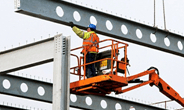Steel Markets

AGC: Labor, Supply Shortages Still Limiting Construction Jobs
Written by David Schollaert
June 18, 2022
More than three-quarters of US states added construction jobs over the past 12 months ended May 2022, though momentum has slowed with less than half adding jobs month-on-month (MoM) in May, according to the Associated General Contractors of America (AGC) analysis of federal employment data.
![]() AGC said monthly employment gains lagged in May, with just 22 states adding jobs versus job gains in 43 states and the District of Columbia annually, as contractors continue to cope with labor shortages and supply chain challenges.
AGC said monthly employment gains lagged in May, with just 22 states adding jobs versus job gains in 43 states and the District of Columbia annually, as contractors continue to cope with labor shortages and supply chain challenges.
“Demand for construction appears to be outpacing the availability of workers and materials in many parts of the country,” AGC CEO Stephen Sandherr said. “Contractors can’t add jobs if they don’t have workers to hire or supplies to install on projects.”
Construction employment increased in 43 states and the District of Columbia YoY in May, while seven states reported declines. Texas added the most construction jobs for the year, an increase of 54,600 to payrolls, up 7.5%, followed by California (+27,800 jobs, +3.1%) and Tennessee (+14,200 jobs, +10.6%). New Mexico had the largest percentage gain, at 12.8%, or 6,000 new jobs, followed by Tennessee and Rhode Island (+10.2% or +2,000 jobs).
Kentucky shed the most construction jobs over the same period, a loss of 2,300 jobs, or -2.9%, followed by Arkansas (-2,000 jobs, -3.6%) and Hawaii (-1,600 jobs, -4.3%). The largest percentage losses were in Hawaii, Arkansas, and Kentucky as well.
In May, only 22 states added construction jobs MoM, while 25 states lost jobs, and there was no change in three states and the District of Columbia. Texas added the most construction jobs over the month, a boost of 10,600 to payrolls, up 1.4%, followed by California (+7,100 jobs, +0.8%) and Minnesota (+4,100 jobs, +3.2%). Minnesota had the largest percentage gain, followed by Tennessee (+1.8%, +2,600 jobs) and Texas.
New York lost the most construction jobs last month, losing 5,100, down 1.3%, followed by Florida (-4,000 jobs, -0.7%) and Ohio (-3,700 jobs, -1.6%). North Dakota (-3.0%, -800 jobs) and Wyoming (-3.0%, -700 jobs) had the largest percentage losses, followed by Iowa (-2.6%, -2,100 jobs).
AGC urged public leaders to continue investing in programs to inform workers about and prepare them for high-paying construction career opportunities. “Too few students and workers are even aware of the many opportunities that exist in the construction industry,” the groups said.
The Association also called on the Biden administration to remove remaining tariffs on construction materials and do more to ease supply chain challenges.
“Contractors need people and products to build projects, and the supply of both is very constrained right now,” Sandherr said.
By David Schollaert, David@SteelMarketUpdate.com

David Schollaert
Read more from David SchollaertLatest in Steel Markets

CMC looks beyond Arizona micro-mill woes to long-term viability of construction mart
Despite the economic and geopolitical upheaval of the last five years, CMC President and CEO Peter Matt points out that the construction market has been an essential element of the way forward.

US importers face stricter rules under revamped S232 tariffs
“CBP expects full compliance from the trade community for accurate reporting and payment of the additional duties. CBP will take enforcement action on non-compliance," the agency said in a March 7 bulletin.

Steel exports rebound in January
US steel exports recovered to a five-month high in January after having fallen to a two-year low in December. This growth follows four consecutive months of declining exports.

Construction spending drops marginally in January
Construction spending edged down slightly in January, slipping for the first time in four months. The US Census Bureau estimated spending at a seasonally adjusted annual rate of $2,196 billion in January, down 0.2% from December’s downward revised rate. The January figure is 3.3% higher than a year ago. January’s result, despite the slight erosion, […]

HVAC equipment shipments slow in December but strong annually
Shipments of heating and cooling equipment in the US fell to an 11-month low in December, according to the latest data released by the Air-Conditioning, Heating, and Refrigeration Institute (AHRI).
